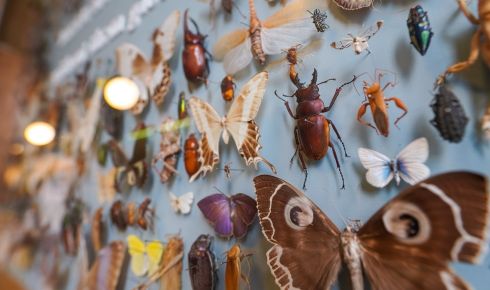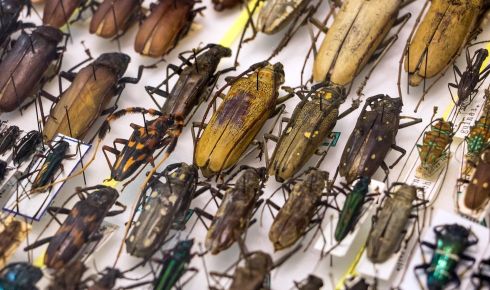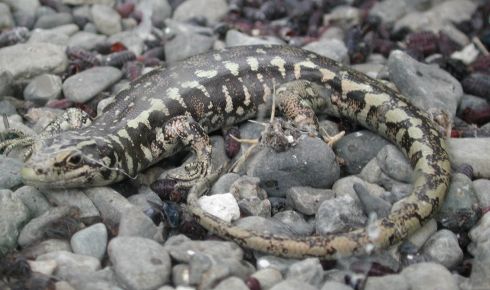Taxonomic trolling

26 May 2025
Darren Naish looks at how a small number of authors can cause chaos in biology’s system for naming species and what can be done about it
The term ‘taxonomy’ refers to the branch of science that is concerned with the naming and classification of organisms. The term ‘vandalism’ refers to an action whereby deliberate damage is caused, usually to property but sometimes to ideas or intellectual efforts. You might think that these two terms have no overlap. You’d be wrong.
Most biologists are familiar with the concept of scientific naming, and today we use the system formally implemented by Swedish botanist Carl Linnaeus in 1758. When a new organism is described, via formal publication, it receives a two-part name, or binomen. This consists of a genus name – one it might share with closely related organisms – and a species name unique to itself.
Coining scientific names has been further formalised and involves registering the name and selecting at least one specimen representing that name – the holotype – in one or more databases. However, for all of the rigour of modern taxonomy, publishing scientific names has a surprising lack of quality control. For starters, there is the principle of taxonomic freedom, which allows an author to publish a name even if scientific principles are not followed. To use an extreme example, if I think the pet cats in my neighbourhood are a new species, I could publish a name provided I follow a minimal set of rules that allow that name to get into print. My work does not need to have been peer-reviewed or published in an academic journal.
In fact, in the eyes of the governing body – in the case of animal names, this is the International Commission on Zoological Nomenclature (ICZN) – all I need to do to make my cat name ‘official’ is ensure that it appears in a work that consists of multiple, simultaneously produced copies that can be obtained from the publisher (there are other requirements if it is published as a PDF).
This system would work fine if everyone was ethical and sensible, employed high standards and lacked the urge to mock, display contempt for or usurp the work of their colleagues. However, a few individuals, from amateurs to academics, have not acted in ethical, sensible ways. They have – according to their peers – vandalised the field of taxonomy.
Vandalism or bad science?
In 2006 a letter signed by more than 120 researchers was sent to Utrecht University about the chaos one of its researchers was causing to beetle taxonomy. His work throughout the 1990s and 2000s was of particular concern – on top of allegedly poor scholarship and a failure to cite previous literature, the bulk of the species and genera he named have been shown to be synonyms of previously named beetles.
The university denied any association with the (mostly self-published) publications of the researcher in question, who then took to sending “disgusting emails to a number of taxonomists”¹. His species names remain and he continues to publish.
Another notorious case revolves around the work of two snail specialists. In a series of self-published books and papers produced between 2014 and 2019, the pair named over 200 supposed new snail species and subspecies, mostly from Southeast Asia. It didn’t take long for specialists to note that many were poorly founded. When specialists accused them of taxonomic vandalism, the pair defended their taxonomic decisions and accused colleagues of “professional jealousy”.
Further examples of scholarship that has been called ‘vandalism’ by specialists can be found in the fungal and orchid communities.
However, accusing colleagues of vandalism is a serious claim and there’s a subjectivity here that muddies the water. Do the examples discussed above really represent vandalism? Perhaps they simply represent unusually shoddy work, where the standards are of a sort deemed unacceptable. After all, vandalism specifically concerns deliberate defacement. Surely no one has ever done such a thing within the field of taxonomy…
Herpetological hotchpotch
The most notorious case of taxonomic vandalism concerns reptiles and amphibians. For decades Australian herpetologists noted that their nation’s herpetological diversity appeared ripe for taxonomic update, and in the 1980s there was substantial revision, most notably in articles led by the Australian Museum’s former deputy director, Harold G Cogger.
However, some argued the Cogger-led work underestimated Australian reptile and amphibian diversity. Especially researchers Richard Wells and Ross Wellington, who – between 1983 and 1985 – self-published two articles that substantially overhauled Australia’s herpetofauna². These works named almost 100 new genera and around 270 new species, many resurrected from synonymy or representing ‘upgraded’ former subspecies.
 The current system of scientific naming was formally implemented by Swedish botanist Carl Linnaeus in 1758
The current system of scientific naming was formally implemented by Swedish botanist Carl Linnaeus in 1758
Wells and Wellington’s primary argument was that taxonomic conservatism had prevented the recognition of species and was putting them in danger due to a lack of conservation status.
There was an immediate outcry from the professional community. The works were labelled “shoddy”, “so perfunctory to be useless” and “hopelessly inadequate”, to quote a 1986 news and views piece from Nature³. In addition, certain names chosen by Wells and Wellington look designed to inflame their critics. Some – like ‘Vaderscincus’ (“named for Mr Darth Vader”) – were frivolous, while others poked fun. The new lizard name ‘Solnonemesis’, for example, means “to set forth the goddess of retributive justice”.
The Wells and Wellington saga culminated in 1987 when the Australian Society of Herpetologists (ASH)petitioned the ICZN to suppress the proposed Wells and Wellington names. However, the ASH framed this as an issue of taxonomic disagreement, not one revolving around the precise workings of taxonomy. Partly for this reason, the ICZN refused to make a ruling and a 1991 statement declared that the names had to stand on their own merits.
The genie was out of the bottle. Other herpetologists with negative feelings towards mainstream academia were emboldened. One character in particular emerged from this era, arguably the most egregious taxonomic vandal on record. Between 1998 and the present, and via a series of self-published journals, this person has published over 2,000 new genus, species and subspecies names, mostly for snakes and lizards but also for arachnids, frogs, mammals and crocodylians.
He generally ‘finds’ new taxa by looking at published family trees, identifying those branches in the trees that are without names and naming them. This was termed ‘nomenclatural harvesting’ by herpetologists Wolfgang Denzer and Hinrich Kaiser in 2023 and, to quote those authors, is a way “to claim easy fame by naming [branches] without scientific rationale or ethical concerns”⁴.
Many of the names are deliberately daft. Genera from 2024 alone include ‘Aaah’, ‘Ah’, ‘Get’, ‘Go’ and ‘Oh’, resulting in species names such as ‘Oh kay’, ‘Oh sheet’, ‘Get it’ and so on.
Names that honour people, termed patronyms, have a long and noble history and are by no means disallowed, but the patronyms published by this researcher are etymological monstrosities, including hard-to-pronounce members of his own family and even his pet dogs. A hateful, anti-establishment streak is present throughout the work, aiming to discredit and derail the work of his detractors, in some cases pre-emptively publishing their hypotheses and even manuscripts, and frequently accusing them of alleged crimes and misdemeanours.
Consequences of vandalism
Scientific names are labels and as such it is sometimes said that they are not that important. The spats discussed above could be regarded as niche debates, pertinent to specialists in a small field, but not otherwise relevant to science or humanity at large.
 Beetles are one of the taxonomic groups most visibly affected by ‘vandalism’, as they contain numerous lineages where scope for taxonomic work remains
Beetles are one of the taxonomic groups most visibly affected by ‘vandalism’, as they contain numerous lineages where scope for taxonomic work remains
The counterargument to this is that names are crucially important if scientists are to keep track of our planet’s inventory of species and determine which are in need of conservation and discussion. We need to agree on the existence of a given species across the areas in which it occurs if we are to implement conservation strategies – and that can be hampered by confusion over taxonomy. Biologists might end up wasting time and resources by untangling taxonomy when they could be doing more constructive work.
Additionally, a key advantage of scientific names is that they are recognisable to speakers of all languages and have a standardisation lacking across common names. This is a key strength when it comes to cross-nation conservation and education, and also medicine and health. Human-wildlife conflict is an increasingly important subject and among the most notable topics within this field is snakebite. Over five million people are bitten by snakes each year and more than 80,000 die. Clearly, administering antivenoms, developing appropriate local responses, public education and collecting data are paramount if these figures are to be reduced. Which snake species are involved, where do they live and what do they look like? It is crucial that a stable taxonomy exists for the species concerned, and confusion could delay medical action and even result in death.
Improving the system
The taxonomic groups most visibly affected by ‘vandalism’ include orchids, snails, beetles, ants and snakes. Partly this is because those groups contain numerous lineages where scope for taxonomic work remains. In addition, these groups are associated with highly expert amateurs.
The IZCN says that in over 250 years of Linnaean taxonomy, the number of authors that could be called ‘taxonomic vandals’ is very small and that the system of scientific naming is “working surprisingly well”. Its current president, Thomas Pape, says that despite repeated calls that new names only be accepted following publication in peer-reviewed journals, crafting such rules to prevent taxonomic vandalism would not be straightforward.
“The day may come where a majority of our ‘community’ (however defined) wants nomenclature to be screened by mandatory peer-review, an ethics committee or any other mechanism. Should that happen, the relevant powers should not reside with the commission,” he says.
“Right now, the commission has both legislative and judicial powers, and in my opinion it would be mistaken to bestow the commission with something equivalent to executive powers. So far the executive powers have been – and are – in the hands of the taxonomic communities.”
Pape insists that the IZCN does issue recommendations to encourage good science and conduct, and enforces some requirements to increase the quality of taxonomic work – for example, that new names (or neotypes) become the property of a recognised scientific or educational institution.
Personally, I believe the disruption, time-wasting and confusion caused by rogue researchers who devise their own (mostly) self-published taxonomic schemes is damaging when it comes to our understanding of the natural world, and for communication. If certain areas of the biological sciences seem to be the domain of slapdash, sub-par research performed by rogue, unserious people, that’s a bad look, given that taxonomy already has an image problem and struggles to justify its perpetuation and funding requirements.
 An Otago skink. Its genus name was officially changed to Vaderscincus, after Darth Vader, in 1983, although most researchers continue to use the original genus Oligosoma
An Otago skink. Its genus name was officially changed to Vaderscincus, after Darth Vader, in 1983, although most researchers continue to use the original genus Oligosoma
Rogue taxonomy also creates problems given that people often need to know which names they should be using. A stable, standardised taxonomy is important, and getting names wrong or confused can have real-world consequences for conservation and medicine. While some amount of humour has always been part of taxonomic history, the most egregious vandals seem to treat the entire field as one big joke.
Given that the ICZN has repeatedly noted its unwillingness to take action against rogue individuals, the onus falls on communities of researchers and on the editorial bodies that control academic publication. In 2013 a team of herpetologists led by Hinrich Kaiser of Victor Valley College, California, argued that biologists need to agree, discipline-wide, that a set of standards should be followed when it comes to scientific naming⁵. It is time to give up on the idea that printing and photocopying self-published articles is sufficient for scientific names to be considered acceptable. Biologists should agree as a community that publication in peer-reviewed, mainstream journals is the filter through which scientific names should pass if they are to be considered scientifically valid.
1) Jäch, M. A. Vandalism in taxonomy. Koleopterol. Rundsch. 77, 38 (2007).
2) Wells, R. W. & Wellington, C. R. A synopsis of the Class Reptilia in Australia. Aust. J. Herpetol. 1, 73–129 (1983); and Wells, R. W. & Wellington, C. R. A classification of the Amphibia and Reptilia of Australia. Aust. J. Herpetol. Suppl. Ser. 1, 1–61 (1985).
3) Thulborn, T. Taxonomy: Taxonomic tangles from Australia. Nature 321, 13–14 (1986).
4) Denzer, W. & Kaiser, H. Naming and gaming: The illicit taxonomic practice of ‘nomenclatural harvesting’ and how to avoid it. J. Zool. 320, 161–168 (2023).
5) Kaiser, H. et al. Best practices: in the 21st century, taxonomic decisions in herpetology are acceptable only when supported by a body of evidence and published via peer-review. Herpetol. Rev. 44, 8–23 (2013).
Darren Naish is a palaeozoological researcher, author, editor, consultant and lecturer affiliated with the University of Southampton.


